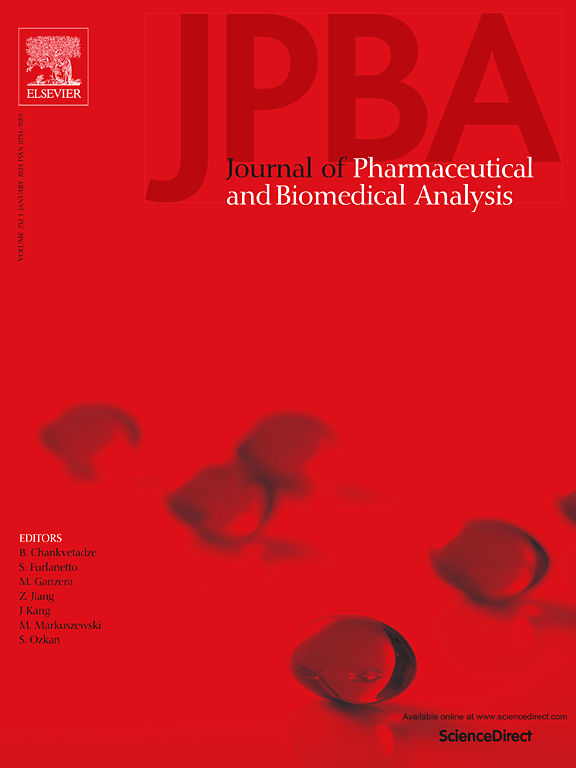Tissue-specific chemical expression and quantitative analysis of bioactive components of Moutan Cortex by laser-microdissection combined with UPLC-Q-Orbitrap-MS technique
IF 3.1
3区 医学
Q2 CHEMISTRY, ANALYTICAL
Journal of pharmaceutical and biomedical analysis
Pub Date : 2024-10-19
DOI:10.1016/j.jpba.2024.116537
引用次数: 0
Abstract
Moutan Cortex, is the root bark of Paeonia suffruticosa Andrews, which is classified into three specifications according to whether or not it is peeled and cored: Liandanpi, Guadanpi and whole root. In this study, the cork layer, cortex, phloem and xylem of P. suffruticosa fresh root were precisely separated by laser microdissection technique. UPLC-Q-Orbitrap-MS and UPLC-QQQ-MS techniques were used to analyse the differences in the chemical composition of different tissue parts of P. suffruticosa fresh root and Liandanpi, and to determine the optimal processing method of P. suffruticosa root. As a result, a total of 90 compounds were characterised, among which the cork layer had more types and higher contents of chemical constituents, and the xylem had fewer types and lower contents of chemical constituents. The proportion of xylem is larger, while the type and content of active ingredients is smaller. Therefore, the processing method of removing the wood core and retaining the cork bark can be used in the processing of Moutan Cortex. In this study, laser microdissection and ultra performance liquid chromatography-mass spectrometry were used to provide a theoretical basis for optimising the processing method of Moutan Cortex to enhance its pharmacological effects.
通过激光微切片与 UPLC-Q-Orbitrap-MS 技术相结合,对牡丹皮的组织特异性化学表达和生物活性成分进行定量分析。
牡丹皮是芍药的根皮,根据是否去皮和去芯分为三种规格:连丹皮、瓜丹皮和全根。本研究采用激光显微切割技术精确分离了荸荠鲜根的木栓层、皮层、韧皮部和木质部。采用 UPLC-Q-Orbitrap-MS 和 UPLC-QQQ-MS 技术分析了苦苣苔鲜根和连丹皮不同组织部位化学成分的差异,并确定了苦苣苔鲜根的最佳加工方法。结果共鉴定出 90 种化合物,其中木栓层的化学成分种类较多,含量较高,木质部的化学成分种类较少,含量较低。木质部所占比例较大,而有效成分的种类和含量较少。因此,在木丹皮的加工过程中,可以采用去木芯保留软木皮的加工方法。本研究采用激光显微切割和超高效液相色谱-质谱法,为优化木丹皮的加工方法以提高其药理作用提供了理论依据。
本文章由计算机程序翻译,如有差异,请以英文原文为准。
求助全文
约1分钟内获得全文
求助全文
来源期刊
CiteScore
6.70
自引率
5.90%
发文量
588
审稿时长
37 days
期刊介绍:
This journal is an international medium directed towards the needs of academic, clinical, government and industrial analysis by publishing original research reports and critical reviews on pharmaceutical and biomedical analysis. It covers the interdisciplinary aspects of analysis in the pharmaceutical, biomedical and clinical sciences, including developments in analytical methodology, instrumentation, computation and interpretation. Submissions on novel applications focusing on drug purity and stability studies, pharmacokinetics, therapeutic monitoring, metabolic profiling; drug-related aspects of analytical biochemistry and forensic toxicology; quality assurance in the pharmaceutical industry are also welcome.
Studies from areas of well established and poorly selective methods, such as UV-VIS spectrophotometry (including derivative and multi-wavelength measurements), basic electroanalytical (potentiometric, polarographic and voltammetric) methods, fluorimetry, flow-injection analysis, etc. are accepted for publication in exceptional cases only, if a unique and substantial advantage over presently known systems is demonstrated. The same applies to the assay of simple drug formulations by any kind of methods and the determination of drugs in biological samples based merely on spiked samples. Drug purity/stability studies should contain information on the structure elucidation of the impurities/degradants.
文献相关原料
公司名称
产品信息
上海源叶
Gallic acid
上海源叶
catechin
上海源叶
oxypaeoniflorin
上海源叶
paeoniflorin
上海源叶
benzoic acid
上海源叶
benzoylpaeoniflorin

 求助内容:
求助内容: 应助结果提醒方式:
应助结果提醒方式:


